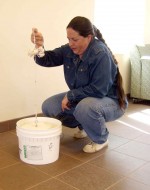It was getting quite embarrassing - during our scheduled summer tours, concerned citizens would get excited about our work at Cedar Creek Ecosystem Science Reserve (CDR) and offer to help. "What can we do to volunteer? What can we do to help?" I was often at a loss. As a research facility, most scientific work is handled by scientists and student interns. Trail maintenance is a function of our capable building and grounds team. A few students from a local community college cleared a few areas of old experiment hardware, what we affectionately call "ecotrash". But even that task wasn't suitable for families or other civic groups. How could we help this body of willing and interested citizens stay engaged?
Then a truly interesting thing happened-a case of "BudBurst to the rescue!" Purely by chance I learned about Project Budburst through Jeff Corney, CDR's associate director. Looking at the postcard he gave me, I wondered whether it would make a nice program for teachers to use with their students. Thus, the seeds for an outreach possibility were planted in my mind. But it was a list of citizen science projects compiled by Barry Jones, Visitor Services Specialist at the USFWS Minnesota Valley NWR, that caused the idea to blossom.
From Barry's list of 52 citizen science projects, I selected five that were either local in scope or easy to conduct. I then contacted members of each project and proposed that they come to CDR for a Citizen Science Field Day to present their projects. Every single one enthusiastically agreed.
The final agenda comprised the following projects: the Minnesota Odonata Survey Project, Minnesota Pollution Control Agency Citizen Lake and Citizen Stream Monitoring Programs, Monarch Larvae Monitoring Project, Project BudBurst, and the CDR-based Red-Headed Woodpecker Recovery Project. The target audience included the general public, teachers, families, 4-H, and Scout groups. The coordinator of Project WILD, which is sponsored by the Minnesota State Department of Natural Resources, donated posters to give away, while refreshments were augmented by a bake sale provided by our local Junior Master Gardener group.
Speakers delivered 15-minute presentations, after which the audience visited each project's display. Topics during the question and answer sessions ranged from sampling techniques for butterfly larvae, to the use of a transparency tube in stream monitoring, to the purpose of fire in maintaining red-headed woodpecker habitat.
The final event of the morning involved participants taking nature walks to see the Red-Headed Woodpeckers in their natural habitat and accompanying Barry to identify trees to use in Project BudBurst. The goal was to empower people with the tools to begin their observations right away.
At the end of the day, 21 participants had attended this first Citizen Science Field Day. The nine presenters each signed on at least one new volunteer and are looking forward to returning to speak next year.
Participants reported being pleased with the level of information given in the presentations, the opportunity to learn and volunteer for the projects, and the chance to get outside and practice some new skills. With minimal input, the event enabled citizens to participate in and contribute to science as well as improve the perception of CDR as a viable, approachable community member.
Mary A. Spivey is CDR's Education Coordinator

 Enlarge this image
Enlarge this image